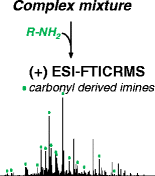Accueil du site > Production scientifique > Semi-Targeted Analysis of Complex Matrices by ESI FT-ICR MS or How an Experimental Bias may be Used as an Analytical Tool
Semi-Targeted Analysis of Complex Matrices by ESI FT-ICR MS or How an Experimental Bias may be Used as an Analytical Tool
Date de publication: 16 janvier 2018
J. Hertzog, V. Carre, A. Dufour, F. Aubriet
Journal of the American Society for Mass Spectrometry 29 543-557 (2018). DOI
Travail réalisé sur le site de l’Université de Lorraine.
Abstract

Ammonia is well suited to favor deprotonation process in electrospray ionization mass spectrometry (ESI-MS) to increase the formation of [M – H]–. Nevertheless, NH3 may react with carbonyl compounds (aldehyde, ketone) and bias the composition description of the investigated sample. This is of significant importance in the study of complex mixture such as oil or bio-oil. To assess the ability of primary amines to form imines with carbonyl compounds during the ESI-MS process, two aldehydes (vanillin and cinnamaldehyde) and two ketones (butyrophenone and trihydroxyacetophenone) have been infused in an ESI source with ammonia and two different amines (aniline and 3-chloronaniline). The (+) ESI-MS analyses have demonstrated the formation of imine whatever the considered carbonyl compound and the used primary amine, the structure of which was extensively studied by tandem mass spectrometry. Thus, it has been established that the addition of ammonia, in the solution infused in an ESI source, may alter the composition description of a complex mixture and leads to misinterpretations due to the formation of imines. Nevertheless, this experimental bias can be used to identify the carbonyl compounds in a pyrolysis bio-oil. As we demonstrated, infusion of the bio-oil with 3-chloroaniline in ESI source leads to specifically derivatized carbonyl compounds. Thanks to their chlorine isotopic pattern and the high mass measurement accuracy, (+) ESI Fourier transform ion cyclotron resonance mass spectrometry (FT-ICR MS) unambiguously highlighted them from the numerous CxHyOz bio-oil components. These results offer a new perspective into the detailed molecular structure of complex mixtures such as bio-oils.








